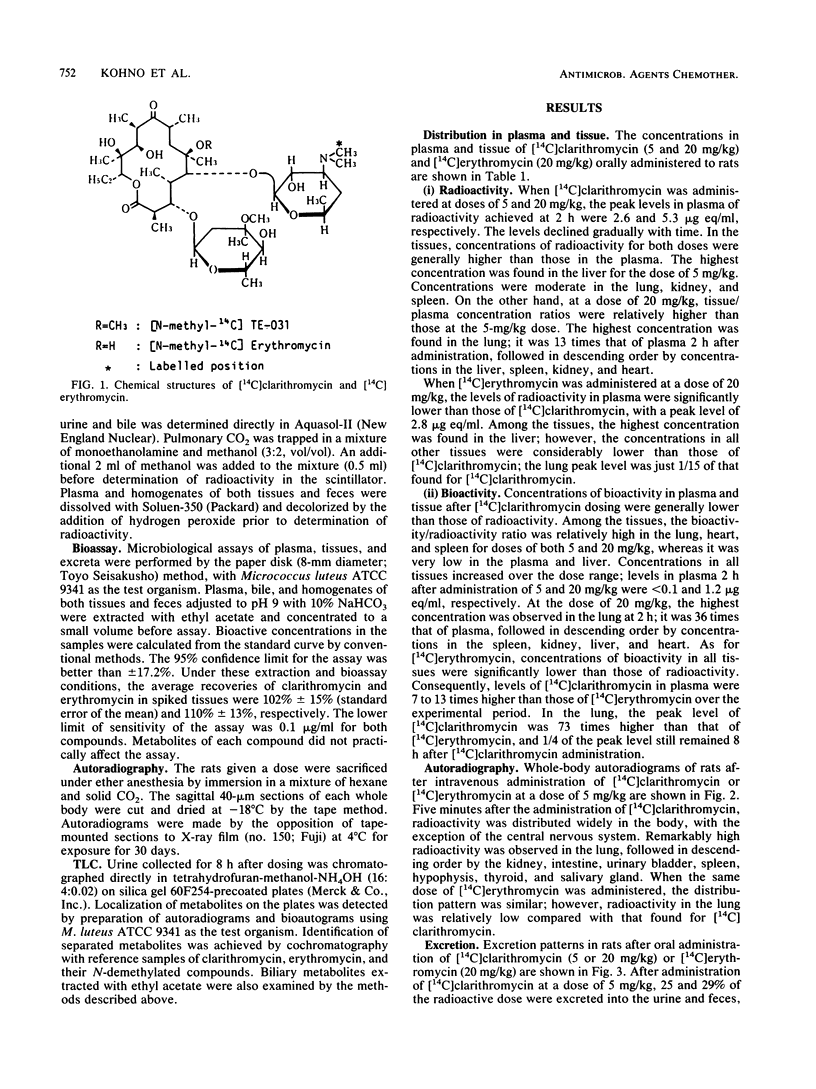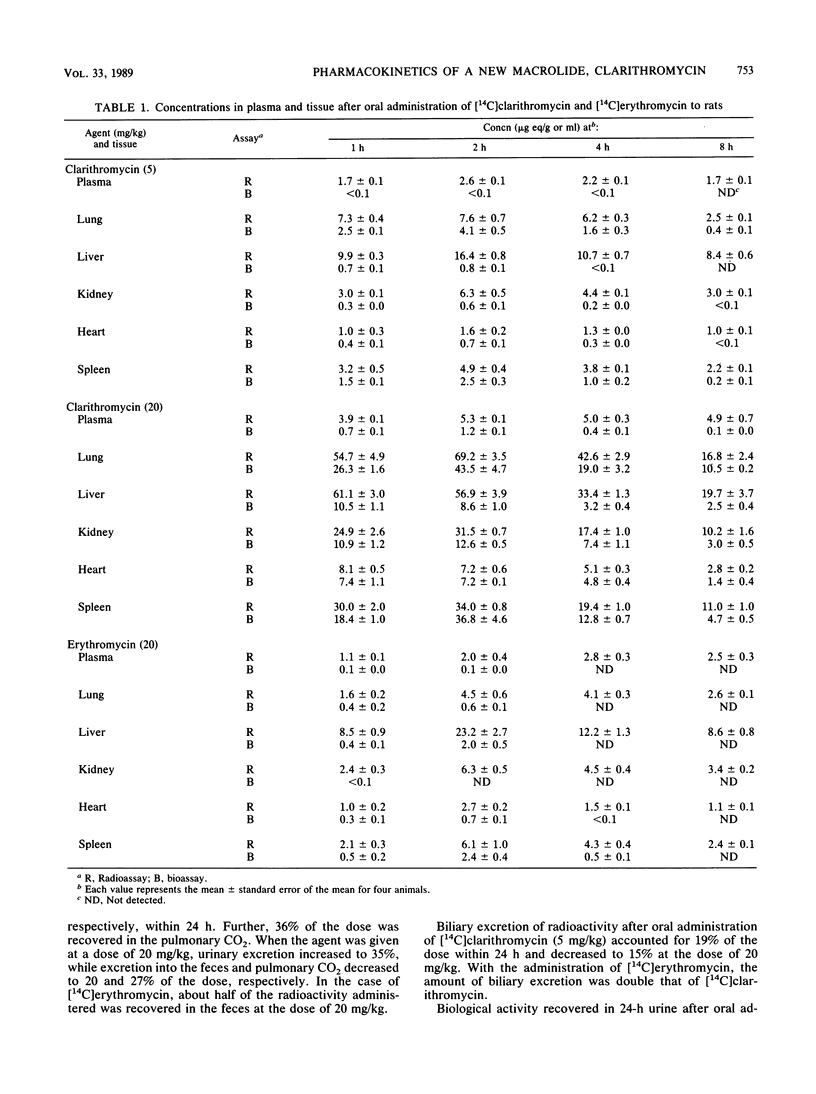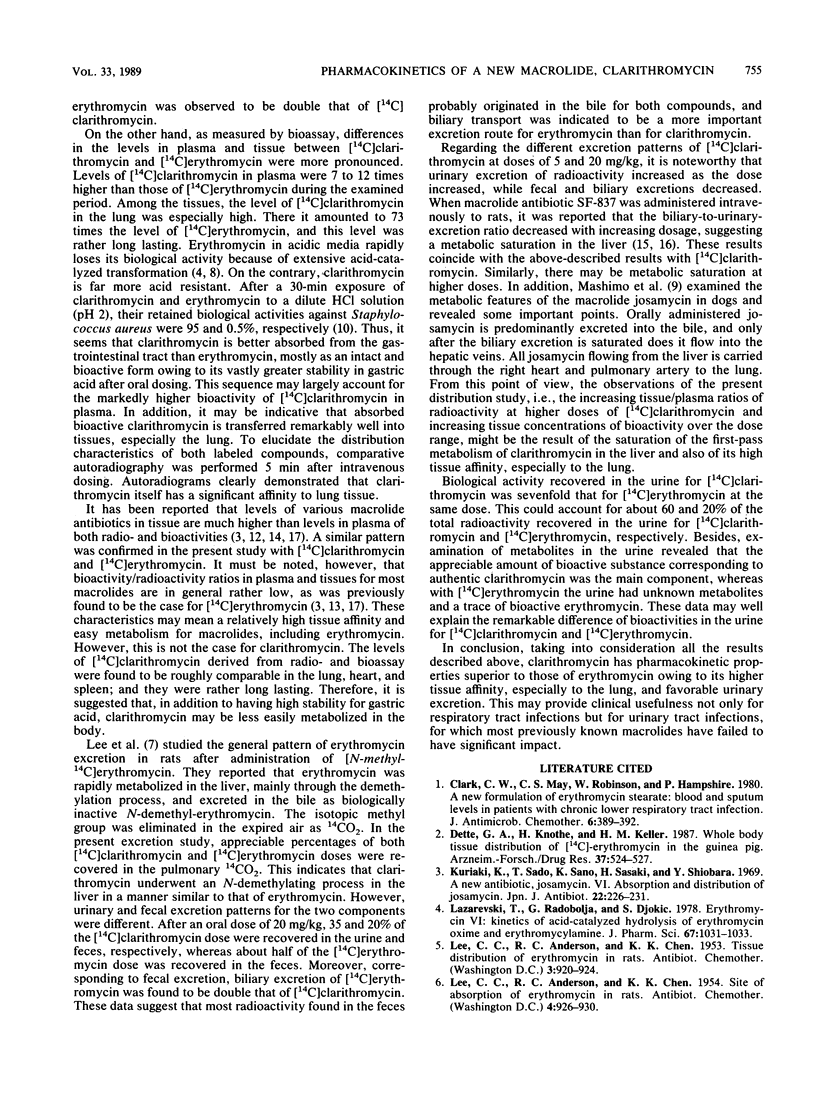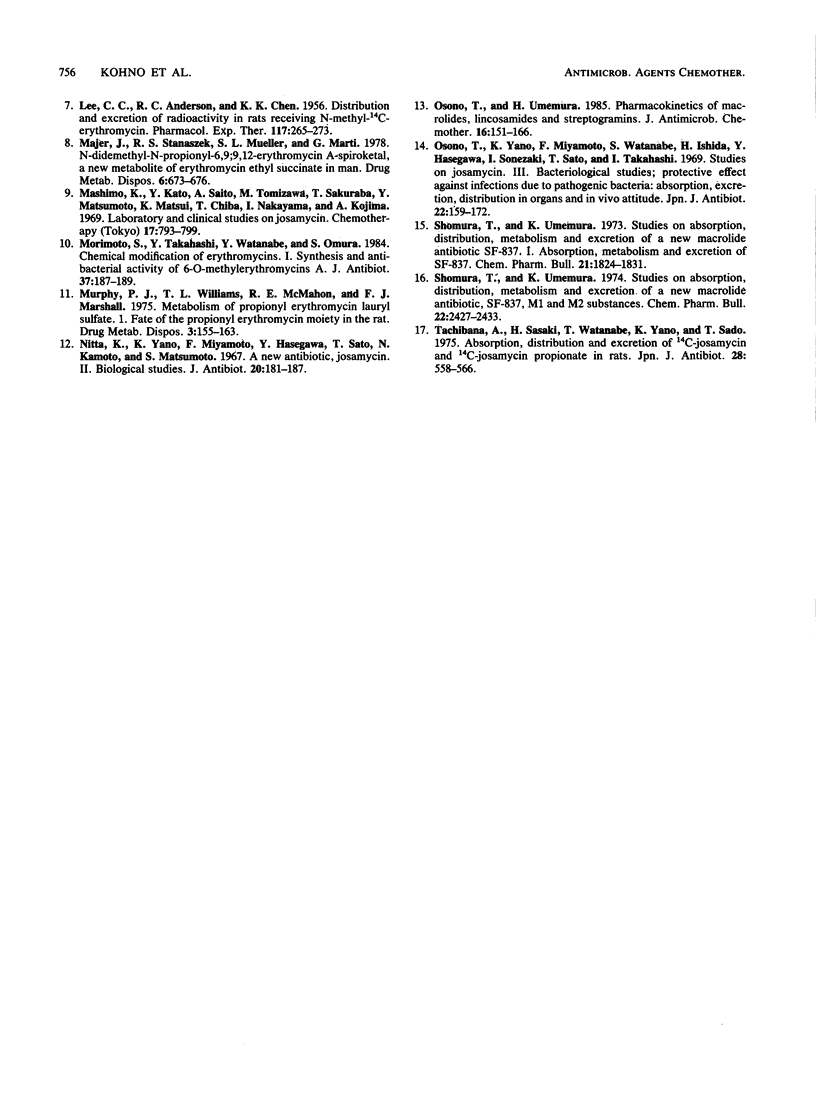Abstract
Clarithromycin (TE-031) is a newly synthesized macrolide with high stability in acidic conditions. In the present study, the pharmacokinetics of [N-methyl-14C]clarithromycin were compared with those of [N-methyl-14C]erythromycin in rats by radioassay and bioassay. Both radioactivity and bioactivity of [14C]clarithromycin in plasma and tissues were found to be significantly higher than those of [14C]erythromycin at the same oral dose of 20 mg/kg (body weight). Among the tissues, the peak level of [14C]clarithromycin in the lung was especially high. Levels of radioactivity and bioactivity amounted to 15 and 73 times the corresponding levels of [14C]erythromycin. In the urine, bioactivity recovered after administration of [14C]clarithromycin was sevenfold higher than that for [14C]erythromycin. This accounted for about 60 and 20% of the total radioactivity in the urine for [14C]clarithromycin and [14C]erythromycin, respectively. An examination of metabolites in the urine for [14C]clarithromycin revealed appreciable amounts of bioactive unchanged clarithromycin. These results indicate that clarithromycin has pharmacokinetic properties superior to those of erythromycin. The desirable properties of clarithromycin include high levels in plasma resulting from its high stability in gastric acid; a high tissue affinity, especially to the lung; and favorable urinary excretion.
Full text
PDF





Images in this article
Selected References
These references are in PubMed. This may not be the complete list of references from this article.
- Clarke C. W., May C. S., Robinson W., Hampshire P., Rawal B. D. A new formulation of erythromycin stearate: blood and sputum levels in patients with chronic lower respiratory tract infection. J Antimicrob Chemother. 1980 May;6(3):389–392. doi: 10.1093/jac/6.3.389. [DOI] [PubMed] [Google Scholar]
- Dette G. A., Knothe H., Kellner H. M. Whole body tissue distribution of [14C]-erythromycin in the guinea pig. An autoradiographic study. Arzneimittelforschung. 1987 May;37(5):524–527. [PubMed] [Google Scholar]
- Kuriaki K., Sado T., Sano K., Sasaki H., Shiobara Y. [New antibiotics, Josamycin. VI. Study on absorption and distribution of Josamycin]. Jpn J Antibiot. 1969 Jun;22(3):226–231. [PubMed] [Google Scholar]
- LEE C. C., ANDERSON R. C., CHEN K. K. Distribution and excretion of radioactivity in rats receiving N-methyl-C14-erythromycin. J Pharmacol Exp Ther. 1956 Jul;117(3):265–273. [PubMed] [Google Scholar]
- Lazarevski T., Radobolja G., Djokić S. Erythromycin VI: kinetics of acid-catalyzed hydrolysis of erythromycin oxime and erythromycylamine. J Pharm Sci. 1978 Jul;67(7):1031–1033. doi: 10.1002/jps.2600670747. [DOI] [PubMed] [Google Scholar]
- Majer J., Stanaszek R. S., Mueller S. L., Marti G. N-Didemethyl-n-propionyl-6,9;9, 12-erythromycin A-spiroketal, a new metabolite of erythromycin ethyl succinate in man. Drug Metab Dispos. 1978 Nov-Dec;6(6):673–676. [PubMed] [Google Scholar]
- Morimoto S., Takahashi Y., Watanabe Y., Omura S. Chemical modification of erythromycins. I. Synthesis and antibacterial activity of 6-O-methylerythromycins A. J Antibiot (Tokyo) 1984 Feb;37(2):187–189. doi: 10.7164/antibiotics.37.187. [DOI] [PubMed] [Google Scholar]
- Murphy P. J., Williams T. L., McMahon R. E., Marshall F. J. Metabolism of propionyl erythromycin lauryl sulfate. I. Fate of the propionyl erythromycin moiety in the rat. Drug Metab Dispos. 1975 May-Jun;3(3):155–163. [PubMed] [Google Scholar]
- Nitta K., Yano K., Miyamoto F., Hasegawa Y., Sato T. A new antibiotic, josamycin. II. Biological studies. J Antibiot (Tokyo) 1967 Jul;20(3):181–187. [PubMed] [Google Scholar]
- Osono T., Umezawa H. Pharmacokinetics of macrolides, lincosamides and streptogramins. J Antimicrob Chemother. 1985 Jul;16 (Suppl A):151–166. doi: 10.1093/jac/16.suppl_a.151. [DOI] [PubMed] [Google Scholar]
- Osono T., Yano K., Mitamoto F., Watanabe S., Ishida H. [Studies on josamycin. 3. (1) Bacteriological studies. (2) Protective effect against infections due to pathogenic bacteria. (3) Absorption, excretion, distribution in organs and in vivo activities]. Jpn J Antibiot. 1969 Apr;22(2):159–172. [PubMed] [Google Scholar]
- Shomura T., Umemura K. Studies on absorption, distribution, metabolism and excretion of a new macrolide antibiotic SF-837. I. Absorption, metabolism and excretion of SF-837. Chem Pharm Bull (Tokyo) 1973 Aug;21(8):1824–1831. doi: 10.1248/cpb.21.1824. [DOI] [PubMed] [Google Scholar]
- Shomura T., Umemura K. Studies on absorption, distribution, metabolism, and excretion of a new macrolide antibiotic, SF-837. II. Pharmacokinetic studies on SF-837, MI, and M2 substances. Chem Pharm Bull (Tokyo) 1974 Oct;22(10):2427–2433. doi: 10.1248/cpb.22.2427. [DOI] [PubMed] [Google Scholar]
- Tachibana A., Sasaki H., Watanabe T., Yano K., Sado T. [Absorption, distribution and excretion of 14C-josamycin and 14C-josamycin propionate in rats (author's transl)]. Jpn J Antibiot. 1975 Aug;28(4):558–566. [PubMed] [Google Scholar]



